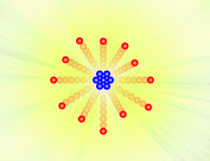Scientists explore new technology to obtain improved snapshots of molecules
When decoding molecular structures with free-electron lasers every femtosecond counts: every single light flash brings the analyzed sample to a fast explosion before its destruction within a millionth of a billionth of a second. A team of scientists from SLAC, TU Berlin and DESY, among them CUI scientist Tim Laarmann, has now studied a method to delay the explosion of the sample for potentially decisive fractions of a second. In their experiments which have now been presented in the scientific journal “Physical Review Letters”, the scientists were able to observe the exact process that takes place in little clusters of atoms intensely irradiated by X-ray light. Laarmann: “Our experiments show that the cluster shell provides the core with electrons for a short time, thus delaying the Coulomb explosion.”

Impression of the explosion of a core-shell cluster in the X-ray light of FLASH.
X-ray lasers as DESY’s FLASH or the European XFEL currently under construction are high-speed cameras for the nanocosm. Their high-energy and ultra-short X-ray pulses allow insights into the smallest dimensions and ultra-fast processes. The problem is that during measurement, the extreme intensity of each single X-ray flash inevitably transforms the investigated sample into a dense plasma and eventually destroys it. When the X-ray flash hits the sample, a great many of the electrons bound in the atomic shell are abruptly knocked out, leaving a molecular structure of highly charged ions flying off in all directions in a so-called Coulomb explosion.
One strategy to prevent the loss of electrons in the sample too quickly is to surround it with a shell layer. During the intense interaction with the X-ray light, the layer is ionized as well; however, the electrons released from the shell will be transferred into the core of the sample, thus compensating the loss of core electrons for a short time.
For the investigation of this explosion delay, the team of researchers led by Tim Laarmann prepared small clusters with a core consisting of about 80 Xenon atoms and a shell of about 400 Argon atoms. They irradiated this cluster with the intensive FLASH X-ray beam and analyzed the fluorescent light emitted by the cluster within the first femto- to picoseconds. Laarmann: “For the first time, we were able to observe the extremely short-lived states generated within the first few hundred femtoseconds by the interaction with the FLASH pulses and exactly see which states of charge are forming in the cluster at the beginning.”
In imaging experiments at FELs, this is valuable time to obtain scattering images of molecules before destruction. In further experiments, the scientists will investigate in more detail the interdependence between delay and size of the cluster.
Original:
“Hidden Charge States in Soft-X-Ray Laser-Produced Nanoplasmas Revealed by Fluorescence Spectroscopy”
Schroedter L., Müller M., Kickermann A., Przystawik A., Toleikis S., Adolph M., Flückiger L., Gorkhover T., Nösel L., Krikunova M., Oelze T., Ovcharenko Y., Rupp D., Sauppe M., Wolter D., Schorb S., Bostedt C., Möller T., and LaarmannT.
Phys. Rev. Lett. 112, 183401 (2014)
DOI: 10.1103/PhysRevLett.112.183401

